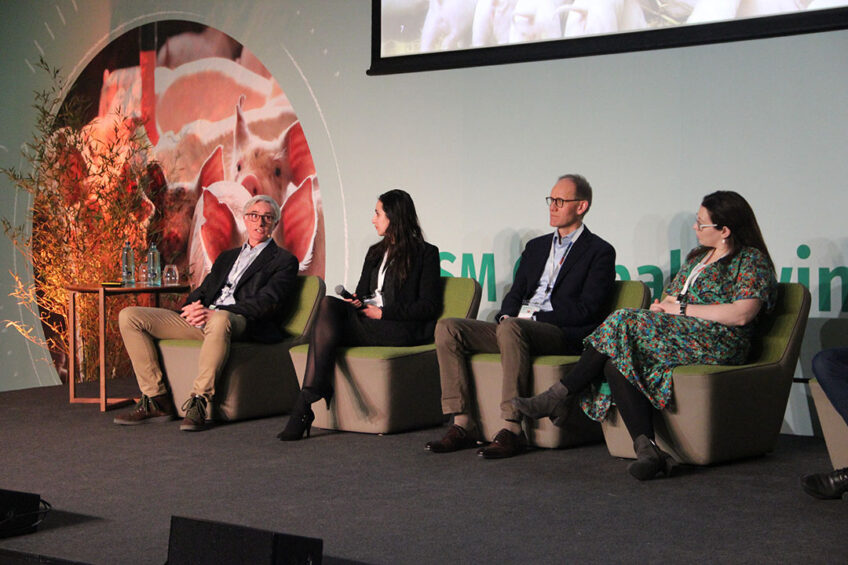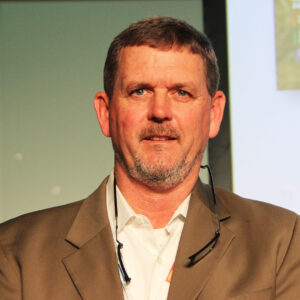Sustainability in pigs debated in 4 hot topics

Madrid, Spain was the centre of the pig producing world during a brand-new 3-day event from 15 to 17 February, set up by animal nutrition company DSM. On the topic of sustainable swine production, the event brought together experts and stakeholders from around the globe to share their views and thoughts.
The 3-day event in Madrid had 4 main “hot” topics:
Global swine trends and outlook,
What decarbonisation means to swine production
Swine resilience and robustness
Precision swine production
In total 21 speakers presented at the event, with 200 experts from over 40 countries attending. They gave their insights into these topics.
 Global swine trends and future outlook
Global swine trends and future outlook
A plenary session took a “helicopter” perspective to discuss what the swine industry looks like at the moment, with attention for global market trends from different perspectives along the value chain. David Hughes, emeritus professor of food marketing at Imperial College, London, UK, gave a very entertaining and interesting presentation about what consumers are concerned about right now. He said pre-pandemic, consumers were concerned about the impact of food and food production on their health and on the health of the planet. He said that one positive thing to have come from the pandemic and the crisis over the last few years is that it has made us think again about food security.
Developments in Ukraine
According to Prof Hughes, the single most influential event as we go into 2023–24 will be whatever happens in Ukraine. He went on to explain the intense retail competition in the UK, how discount stores are price-matching many of the major supermarket chains, and consumers are shopping more consciously and looking at value for money.
Consumers’ concerns
He said that while consumers are concerned about the environment and animal welfare, they also have other concerns, like “Can I afford to eat, or do I have to heat?” He went on to say that activists, for a while, were driving the global concern about the health of the planet, but governments, large and small, also have a part in this. The people closest to food consumers make grand promises on food sustainability that those on farm level need to deliver.
Social pressures dictating what not to eat
He had a list of social pressures dictating what not to eat, which includes anything with palm oil and anything in a non-recyclable pack. Prof Hughes said this list is growing. Consumers are concerned about sow “slavery” and piglet welfare, and will buy anything with an adjective in front of it: free-range, raised outdoor, hand-cured and beech wood smoked, etc., although some people will still just buy the cheapest.
He concluded his presentation with some food for thought: In general, consumers have more trust in farmers than in any other players in the food industry.
 Decarbonisation
Decarbonisation
This session looked at decarbonisation and what it means for swine production. Kraig Westerbeek, chief development officer at Monarch Renewables, which is part of the largest swine producer in the US, Smithfield Foods, talked about Smithfield’s carbon reduction journey that they officially began back in 2016. After developing aggressive goals in this area, Smithfield implemented programmes to reduce greenhouse gases (GHG) in the areas of highest contribution.
Manure management
Manure management was one of the largest opportunities to reduce their GHG footprint, and others were in grain farm and feed milling, processing plants, transportation and, lastly, working with retailers and consumers. Smithfield reduced its overall carbon footprint by 13% from its 2010 baseline.
In the area of manure management, Smithfield saw an opportunity to convert methane emissions into renewable energy. It placed digestors on farms to collect CO2 and methane and convert them into biogas. This in turn is transformed into renewable natural gas (RNG). Westerbeek mentioned that there are many benefits to using RNG, such as providing new revenue streams for family farmers.
Grain sustainability
Westerbeek also covered Smithfield’s commitment to grain sustainability. Smithfield’s agronomics programmes have implemented efficient fertiliser and soil health on more than 1 million acres (405,000 ha) of American farmland to date. The company also had a goal of obtaining 50% of electricity needs from renewable sources by 2030, which it has surpassed.
Production efficiency
He also talked about production efficiency. He said that anything that can help make animals more efficient is likely to reduce the carbon footprint, as well as the air and water footprints.
Minimise food waste
Emissions in the areas of retail and food waste fall outside of Smithfield’s scope, Westerbeek said. Their focus is therefore on producing more shelf-stable and pre-cooked foods with smaller portions, to minimise food waste. Also, the company is looking at making packaging 90% recyclable, reusable or compostable by 2030.
He concluded by saying that finding ways to be more sustainable and more efficient actually helps overcome inflationary pressure.
 Swine resilience and robustness
Swine resilience and robustness
Researcher Dr Wendy Rauw from the Spanish research institute INIA-CSIC talked in her presentation about fattening pigs: Has genetic selection predisposed modern pigs to inflammation?
She covered 3 main areas:
Selecting for high production efficiency;
Consequences of selection on the immune response; and
Breeding for resilience and robustness
Dr Rauw said genetic improvement of pigs over the past decades has resulted in unprecedented improvements in lean growth, carcass quality and feed efficiency of commercial grower-finisher pigs. Producers select for improved production on one side (which in the case of fattening pigs is growth rate, or meat production) and on the other side select for reduced inputs (because pigs ended up having reduced body reserves due to selection for leanness and because they have been selected for improved feed efficiency).
This may reduce the metabolic space of animals to respond well to physiological demands (including responding adequately to health challenges and stress), leading to trade-offs between production and adaptation to environmental stressors. These high-producing animals tend to be more sensitive to the environment – exposure to disease, social stress and temperature – which may reduce reproduction and production levels and predispose the animals to disease and inflammation.
Novel techniques
Dr Rauw concluded by saying that novel techniques – such as big data analytics, novel genetics, genomics and breeding methods – may improve the ability to select for animals that are more robust and resilient to disease challenges and other fluctuations in the environment, for example thermal stress or dealing with new feed.
 Precision swine production
Precision swine production
Aidan Connolly, president of AgriTech Capital, began his presentation with what he thinks is changing in the world of agriculture. He said that obviously the biggest challenge is going to be feeding the ever-growing population. Disease is a big challenge in the pork industry, as is continuing to make food more affordable. That requires more precision in animal nutrition, health and welfare. Health and food safety still need to be continually addressed, as does the environmental footprint.
Disruptions
According to Connolly, most producers think about the next 10 to 12 years when asked about the future of the swine industry. But he said that disruptions are happening at a speed that suggests that it needs to be looked at more radically, like the next 24 months. “Changes are occurring,” he said, pointing to whether robots could be part of the swine industry as nutritionists or with a role in the veterinary decision-making process. Change is inevitable in the pig industry, just like the banking industry (SocietyOne), taxi industry (Uber) and media industry (Facebook).
Different pig business
He wondered if there was a young person out there at this moment, imagining a completely different way of producing/growing animals, thinking of a pig business that is completely different to what is known today. What would it look like? How many animals per pen? Do we need 3,000 animals in a house? Why are the processing plants so far away from the farms? These are things which are accepted today as set in stone.
Innovation is increasing
Innovation is increasing, he said, and is continuing to grow. Cropping industries are way ahead of the swine industry in terms of using technology such as drones, blockchain, sensors and automated tractors. The pig producer knows very little about an individual animal’s real-time bodyweight, feed consumption and body temperature. Most feeds are formulated based on averages.
Transforming the pork industry
What would make pig production better? He mentioned some possibilities: knowing the stress and comfort levels of the animal, being able to spot disease before the entire pen is infected, and knowing the air quality and temperature in a pen.
Connolly picked 10 technologies that could transform the pork production industry, some of which were:
3D printing, to print machine parts immediately, minimising production losses;
Robots, to help increase production and do work such as cleaning floors; they don’t tire easily;
Artificial intelligence, which can mimic human actions, constantly monitor herds and eliminate human error;
Augmented reality, to allow users to see what the unaided eye cannot; can detect bacteria;
Virtual reality, to train people in veterinarian colleges; allows animals to be checked remotely;
Blockchain, which provides complete supply chain traceability for every step of the food production process; and
Sensors, which enable the Internet of Things by collecting data to contribute to smarter decisions; can monitor the environment and animals; help to understand how the animals move, their behaviour and monitor vitals.
He concluded his presentation with some thought-provoking questions about agri-business in ten years time: “What will it look like? Will technology disrupt it?”











